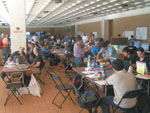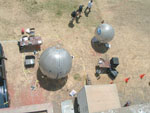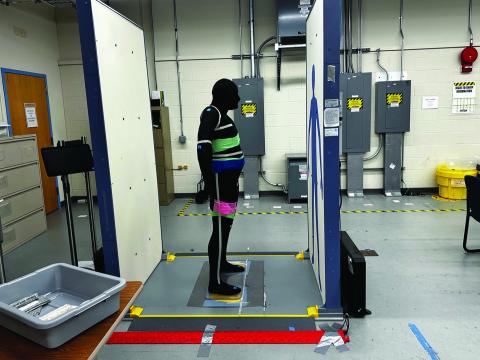Simulated Catastrophe Focuses on Tools to Create Order From Chaos
 |
| The goal of the Strong Angel III demonstration was to develop new technologies and applications for use in disaster relief. The event simulated the loss of power and communications following a cyberterrorism attack during a global pandemic. Participants were forced to work together to set up ad hoc networks and to modify existing software applications to operate more efficiently in a harsh environment. |
Disaster areas are chaotic, demanding, challenging environments for both the survivors and the organizations trying to help them. A recent international demonstration examined ways to develop new applications and technologies to coordinate disaster recovery operations better. The event also focused on building social networks between the participants to streamline and accelerate future relief efforts.
The goal of Strong Angel III was to devise new tools and to foster dialogue among the many groups involved in crisis management and recovery operations. Held in
To emphasize the lack of infrastructure, the simulation took place in
More than 50 private sector technology firms including Microsoft, IBM and Google were present to provide connectivity and communications solutions. However, the commercial groups were forbidden from selling or promoting their products. Their role was to collaborate with each other to develop applications. “When you force people to interact toward an honorable, approachable goal where cooperation is clearly in everyone’s best interest, you have some unique bedfellows,” Cmdr. Rasmussen says.
Strong Angel III also focused on breaking down institutional barriers between the military and international nongovernmental organizations (NGOs). Eleven NGOs from nations such as
The largest Defense Department group present was the U.S. Joint Forces Command (JFCOM), which is working to develop methods for sharing information with civilian groups during humanitarian operations. Cmdr. Rasmussen observes that the military already has experimented with such procedures. He notes that he recently deployed to
Among the technologies and applications demonstrated at Strong Angel III, one that received much attention was Sahana. Developed by the Lanka Software Foundation,
Another software package that was enhanced during the event was a framework for failed state reconstruction. Developed by
An information-sharing software program called Groove also proved popular with the participants. Groove evolved from Lotus Notes and is now part of the Microsoft Office 2007 software package, providing chat, file sharing, discussion groups, real-time awareness, and audio and video collaboration. “It was the core application we used in the eight months prior to Strong Angel III and during the event. When we were down supporting Hurricane Katrina recovery efforts, Groove was the application of choice because it works,” explains Cmdr. Peter Griffiths, USN, Office of the Secretary of Defense for Networks and Information Integration and a member of the event’s executive committee.
Perhaps the most popular technology used during Strong Angel was the Fossil Abacus smart personal object technology (SPOT) watch. This is a wristwatch with an embedded FM radio receiver designed to receive text messages. Although the watches are primarily intended for personal use, a portable and configurable FM transmitter with a 50-mile radius allows the devices to operate in areas without infrastructure, power or Internet connectivity. Messages can be sent to selected groups of SPOT wearers, such as police, fire department personnel and National Guard troops. Robert Kirkpatrick, lead architect of Microsoft’s Humanitarian Systems Group,
 |
 |
| Among the technologies highlighted at Strong Angel III were the smart personal technology object (SPOT) watch (t) and lightweight inflatable satellite dishes by GATR Technologies (b). The SPOT watch is a wristwatch that receives text messages. The device can be set so that specific users such as police or fire department personnel can receive different messages. The GATR satellite dishes are designed to be easily transported by vehicle or backpack into devastated areas to provide vital connectivity. |
Another communications technology presented during Strong Angel III consisted of inflatable satellite dishes manufactured by GATR Technologies,
Route 1 Incorporated,
The value of Strong Angel III was that it allowed people from different organizations to gather in one place and to garner information from individuals who are experienced in disaster relief. The dialogue was mutual, with design and application experts asking their customers what they needed in humanitarian environments and government and NGO representatives seeking better applications to meet their needs. Cmdr. Griffiths describes this process as “applying a bit of rudder” to get developers to fine-tune their applications. “But you can’t do that unless you get people together without any pressures—no real-world disasters or concerns for safety and health. You’ve got the ability to focus on what you are trying to do and what you will do in a disaster. We could do this over the phone, but the magic really happens when you get people together and let them set the course,” he says.
Speaking from a private sector perspective, Kirkpatrick explains that Strong Angel allowed his team to discover the limitations of Microsoft product design and to find approaches capable of operating under difficult conditions. He notes that working in such a chaotic environment gives developers an insight into the future. “People working in this very collaborative, interorganizational space where you have to visualize everything—that’s the way the world is going,” he says.
The event allowed Microsoft and other firms to experiment with new technical approaches and to learn from the situation. Kirkpatrick notes that the company’s product teams came back from the event with a mix of successes and failures. “Strong Angel was designed to put enough pressure on the technologies so that not everything was going to succeed. We deliberately set it up that way. It was a very harsh environment,” he says.
Strong Angel also provided the inspiration and the means for participants to integrate applications across different products and systems. For example, organizations tend to arrive at a disaster with their own equipment and tools such as global information system (GIS) applications. The vendors and developers at the event, most notably Microsoft and Google, worked together to make these various applications interoperate. Kirkpatrick notes that it should not matter if a user has a U.S. Army or a Red Cross GIS mapping system; they all should show the same data during a disaster. “I want the dot to show up on the map for all of the different systems,” he says.
A key lesson learned during the week in
The lack of connectivity forced the participants to shut their ad hoc network down and restart it piece by piece. This process was an important lesson because it compelled the various groups to interact with each other to get their systems operating, Kirkpatrick explains. He adds that technical obstacles are usually cited as a reason why some organizations cannot work together, but this is often a mask for a more fundamental inability or unwillingness to communicate at the human level.
Kirkpatrick notes that although technology is vital for coordinating and managing disaster relief efforts, the very act of exploring technical solutions for a shared problem fosters mutual cooperation among participants. He believes it is this social interaction that is the most valuable product of Strong Angel III. Another important factor was that as the commercial vendors became involved in conversations about creating new applications and requirements, they served as a bridge between organizations that do not usually interact with each other. “You can say that commercial vendors are in this for the money—that’s fine. But we’re not civilian and we’re not military—we’re neutral. Technology and the companies that support it can be bridge builders because we don’t have a particular bias,” he says.
Web Resources
Strong Angel III: www.strongangel3.net
Sahana: www.sahana.lk
GATR Technologies: www.gatr.com




Comments